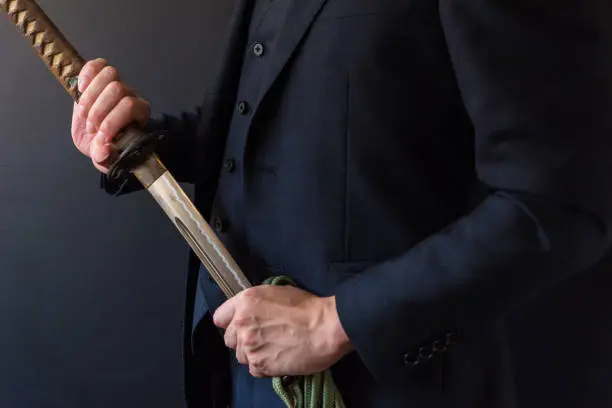Introduction
The authentic katana is more than just a weapon — it is a symbol of Japanese culture, artistry, and spirit. For centuries, this curved, single-edged sword has represented honor, discipline, and precision. Crafted with skill passed down through generations, the katana continues to fascinate historians, collectors, and martial arts enthusiasts worldwide. Its elegance lies not only in its physical form but also in the deep cultural significance it holds within Japan’s samurai tradition.
The Historical Origins of the Authentic Katana
The history of the authentic katana dates back to Japan’s feudal period, around the 14th century. Before the katana, Japanese warriors used straight swords known as chokuto, which were influenced by Chinese designs. However, as warfare evolved, so did the need for a faster, more efficient weapon that could be drawn swiftly and used effectively in combat.
Swordsmiths began developing curved blades that allowed for smoother drawing and cutting motions. This innovation gave rise to the katana, a weapon perfectly balanced between strength and flexibility. It became the primary weapon of the samurai, Japan’s noble warrior class, who treated it as both a fighting tool and a sacred object that embodied their soul.
Craftsmanship and the Art of Forging
The process of crafting an authentic katana is an art that requires mastery, patience, and devotion. Traditional swordsmiths, or katanakaji, follow centuries-old techniques to ensure the blade’s perfection. The making of a true katana can take several weeks or even months, depending on the level of detail and artistry involved.
- Steel Selection (Tamahagane):
The process begins with tamahagane, a special Japanese steel made from iron sand. Swordsmiths use a clay furnace called a tatara to refine the steel, separating impurities and achieving the ideal carbon balance for strength and flexibility. - Folding the Steel:
The steel is repeatedly heated, hammered, and folded — sometimes over a dozen times. This process not only strengthens the blade but also creates the beautiful grain pattern known as hada, which is unique to each sword. - Blade Shaping and Quenching:
The swordsmith then shapes the blade and coats it with a clay mixture before heating and quenching it in water. This differential hardening process forms the distinct curved shape and produces the iconic hamon (temper line), which is a hallmark of an authentic katana. - Polishing and Mounting:
After forging, expert polishers bring out the blade’s sharpness and shine using fine-grit stones. Finally, artisans craft the fittings, including the handle (tsuka), guard (tsuba), and scabbard (saya), completing the masterpiece.
Every step in this process showcases the unparalleled dedication and craftsmanship that make an authentic katana a true work of art.
Symbolism and Cultural Significance
For the samurai, the katana was not merely a weapon — it was an extension of their spirit. They followed the Bushido code, which emphasized honor, loyalty, and discipline. Owning and wielding an authentic katana symbolized moral strength and personal responsibility.
Even after Japan’s samurai era ended in the late 19th century, the katana continued to represent the country’s artistic heritage and philosophical ideals. Today, it stands as a global icon of Japanese culture, revered in martial arts, museums, and private collections.
The Difference Between Authentic and Replica Katanas
While replica katanas are widely available, an authentic katana is distinguished by its craftsmanship, materials, and historical integrity. Here are a few key differences:
- Material Quality:
Authentic katanas are made from tamahagane steel, while replicas often use stainless or carbon steel without traditional forging methods. - Forging Technique:
True katanas are hand-forged using traditional Japanese techniques, not mass-produced in factories. - Cultural Value:
Authentic swords carry deep historical and cultural meaning. Many are considered national treasures and can only be crafted by licensed swordsmiths in Japan. - Aesthetic Details:
The subtle grain (hada) and temper line (hamon) are natural results of the forging process in genuine blades, while replicas often feature artificial engravings.
If you’re considering purchasing or collecting one, ensure it’s made by a certified Japanese swordsmith or an artisan trained in authentic techniques. Reputable sellers, such as Mini Katana, offer both display and functional katanas inspired by traditional craftsmanship.
Modern Uses and Appreciation
In the modern world, the authentic katana has found new relevance beyond the battlefield. Martial artists practicing disciplines like Kendo, Iaido, or Kenjutsu still use traditionally made swords to preserve the spirit and skill of ancient warriors.
Collectors admire authentic katanas as valuable historical artifacts, appreciating their aesthetic beauty and technical perfection. Meanwhile, pop culture — through films, anime, and video games — continues to immortalize the katana as a symbol of courage and precision.
Caring for an Authentic Katana
Owning an authentic katana also means respecting its craftsmanship through proper maintenance. Traditional sword care involves regular cleaning and oiling to prevent rust, as the high-carbon steel is sensitive to moisture. Enthusiasts often use uchiko powder and choji oil to preserve the blade’s integrity and shine. Proper handling and storage are equally important to ensure the sword’s longevity and authenticity.
Where to Find Authentic Katanas Today
Finding a true authentic katana requires research and trust in reputable sellers. Collectors often seek certified Japanese swordsmiths or specialized stores that value traditional forging methods. For those who wish to own a piece of Japanese history or a beautifully crafted sword for martial arts or display, Mini Katana offers an excellent selection inspired by genuine craftsmanship.
Their collection features both traditional and modern interpretations, allowing enthusiasts to experience the elegance and spirit of this legendary weapon in various forms.
Conclusion
The authentic katana stands as one of the most remarkable symbols of Japan’s rich cultural heritage. Its creation involves not just the mastery of metallurgy but also the embodiment of values like discipline, honor, and artistry. Each blade tells a story — a story of generations of swordsmiths who perfected their craft, and of warriors who lived by the sword’s moral code.
Whether admired for its beauty, collected as a piece of history, or wielded in martial arts, the katana remains an enduring emblem of Japan’s spirit. Owning an authentic katana means holding a tangible connection to centuries of tradition, craftsmanship, and timeless artistry.

